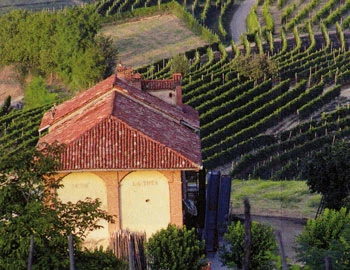Gut Oggau
What’s the secret of the wines of Austria's Gut Oggau?
Gut Oggau wines are among the best organic wines in Austria, and are produced by Eduard Tscheppe and his wife Stephanie Tscheppe Eselböck on the shores of Lake Neusiedl in Burgenland.
Before Eduard founded the winery, he produced conventional wine with his father in Styria, while Stephanie’s family owned and operated the Michelin-star restaurant & hotel Taubenkobel. They restored the 17th century winery, which had been abandoned for many years. When the restoration was completed in 2007 they started with nine hectares. Today, almost 15 years later, they own 15 hectares and are Demeter certified. The previous owner of the winery was a 92-year-old woman with no children. She hadn’t tended the vineyards for several years. That was an exciting challenge for the young couple. Fortunately, there had been a gap of several years between owners, so the soils had a chance to recover from the chemicals that had been used previously. It was important to Stephanie and Eduard not to change the vineyard, and instead they embraced its natural potential. From the very beginning their approach has been to work with nature and to handle the soil and the vines with great care with the focus on sustainability. They were amazed at just how much character the barrels revealed in the very first vintage; each wine seemed so alive, shining bright with its own personality – and thus the Gut Oggau family was born.
White wines from Gut Oggau
Rosé wines from Gut Oggau
Red wines from Gut Oggau
from Gut Oggau
The couple realised that the unique environment required careful cultivation and therefore focused on producing high-quality wines from grapes that they processed as gently as possible. The result? Their wines are among the most sought-after in Austria. These organic wines are a family in the truest sense of the word.
The label of each bottle features a hand-drawn black-and-white portrait of a fictional family member, one of three generations. The younger generation was planted on the gravel soils, which give the wine a more lively, youthful character. In contrast, the older generations come from vines planted on the limestone and slate soils of the slopes above the village, which give the wines a mature, ‘grown-up’ personality. The back labels explain the imaginary personality of each wine. You shouldn’t judge a book by its cover, but should you judge a wine by its label? Not really! However, the Gut Oggau family members may well be the exception to the rule! For instance, we learn that Mechthild (a white wine and the grandmother) is the “kind-hearted grandmother” who evokes feelings of nostalgia. She is trustworthy, but can also be mysterious and tends to polarise opinions. Atanasius (a red wine, grandson and “a handsome young man”) is known for his exceptional good looks and easy-going manner. Emmeram (a Gewürztraminer), is convinced that Theodora (white), the daughter of Wiltrude (a daughter-in-law and sweet white), is actually his. Whether it's the energetic and spirited children Atanasius, Theodora and Winifred, the more seasoned parents Joschuari, Emmeram, Timotheus and Josephine or the somewhat more traditional grandparents Mechthild and Bertholdi – getting to know this fascinating family is a real feast for the palate!
Producer

Pievalta
The Pievalta estate is located in the municipality of Maiolati Spontini, in the Marche region, in the heart of the Castelli di Jesi. This area is famous for its small fortified medieval villages as well as for the production of wines made from the Verdicchio grape.

Marchesi Alfieri
At the intersection of Roero, Langhe and Monforte, between Asti and Alba, lies the small medieval village of San Martino Alfieri. The magnificent baroque castle of the Marchesi Alfieri and the Azienda building are located on the hill.

Domaine Julien Brocard
The seven vineyards - Chablis "naturally"
Julien Brocard's domaine is located in Préhy, just a few kilometres from the town of Chablis in northern Burgundy. The aim of the domaine is to bring out the true character of the wines without any distortion, and for this purpose the vines have been cultivated biodynamically since 2011.















